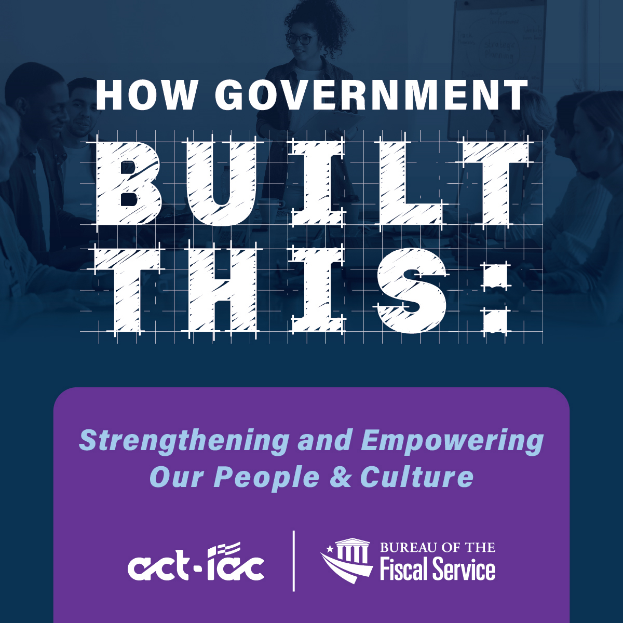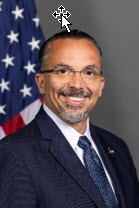

‘How Government Built This - Strengthening and Empowering Our People & Culture’ – How Psychological Safety paves the way for Empowerment

Welcome to “How Government Built This,” a podcast and blog post series developed by the Department of the Treasury’s Bureau of the Fiscal Service Office of Financial Innovation and Transformation (FIT) in collaboration with the American Council for Technology and Industry Advisory Council (ACT-IAC). This series will spotlight trailblazers exploring the intersection of innovation and Diversity, Equity, Inclusion, and Access or DEIA across government. Resources and links mentioned in each podcast will also be available at actiac.org/thebuzz. This episode also is co-sponsored by the National Council of Hispanic Employment Program Managers.
 Glorimar Maldonado, Diversity Officer, United States Patent and Trademark Office
Glorimar Maldonado, Diversity Officer, United States Patent and Trademark Office
Ms. Maldonado provides policy review, technical guidance, data-driven analyses, and strategic leadership for Diversity, Equity, Inclusion and Accessibility (DEIA) programs and initiatives to recruit, retain, engage, and develop a prepared, diverse, and sustainable workforce.
As an instructor, she conducts employment and professional/leadership development workshops and K-12 activities that promote careers in mathematics and the sciences.
Previously, Ms. Maldonado was the Interim Deputy Director for Talent Acquisition and the first-ever Latina Chief Recruitment Officer for the U.S. Department of Health and Human Services. In this role, she developed, reviewed, and implemented policies, programs, and initiatives to streamline and improve federal hiring and retention practices, implement robust diversity recruitment practices, and promote DEIA in the workforce.
 Javier Inclan, Assistant Inspector General for Management and CIO, Office of Inspector General, National Science Foundation
Javier Inclan, Assistant Inspector General for Management and CIO, Office of Inspector General, National Science Foundation
Mr. Inclán has responsibility for the OIG's budget, human capital, IT operations, DEIA, training, policy and planning, and other administrative support services.
He also serves as a member of the Senior Executives Association Board of Directors and as the Vice-Chairperson of the National Council of Hispanic Employment Program Managers. Before joining the OIG, Mr. Inclán served as the Deputy Office Head for the Office of Equity and Civil Rights at National Science Foundation.
The term "psychological safety" is used quite a bit now. What is it? Where do you see it most?
Javier explained that psychological safety is defined as the "shared belief by members of a team that the team is safe for interpersonal risk-taking." It means that someone can bring their entire self to work and make recommendations and ask questions without fear of retribution or repercussions. Javier referenced Tim Clark, who described four stages of psychological safety: 1) Inclusion Safety, 2) Learner Safety, 3) Contributor Safety, and 4) Challenger Safety. Together, these stages represent psychological safety.
Javier noted that it is especially important to be aware of psychological safety. People are more empowered to communicate what they want to say. This communication must be professional and respectful, without animus toward leadership or fellow team members. Individuals should feel safe to challenge the status quo and contribute thoughts and ideas without a negative reaction.
Is psychological safety just another way of saying trust? If not, how are they different?
Glorimar explained that psychological safety overlaps with trust but is a different concept. Psychological safety is experienced at the team level. It is about being able to bring your whole self to work and be comfortable taking the risk of sharing an idea or critiquing an idea. You build trust with one another, and this rolls up to psychological safety at the group level.
Do mental health and overall well-being and wellness play a role in psychological safety?
Javier stressed the link between wellness and psychological safety. He has had experiences with people coming to him to share that they are not psychologically safe or do not perceive that they are, and so they’ve withdrawn at work and cannot express themselves without fear of retribution.
Recalling Glorimar's distinction between trust and psychological safety, Javier noted that while trust between two people may be stable, psychological safety is ever changing as teams are always changing. Team members join and leave, or leadership turns over. So, psychological safety is a journey not a destination.
Javier observed that people need stability and need to feel comfortable. The absence of comfort creates a potential mental health issue and affects wellness. If a person's psychological safety decreases as colleagues leave or new leadership emerges, or the person lacked psychological safety from the beginning this can impact their wellness.
What factors drive psychological safety?
Javier observed that psychological safety is closely tied to the diversity of teams. If someone is an outlier on the team, they may feel less comfortable. It is incumbent on the rest of the team to establish a psychological safe space and reassure that team member.
Glorimar noted that psychological safety is a group effort and is misperceived as solely a leadership responsibility. She stressed that while leadership may be responsible for setting the tone and creating momentum for psychological safety, everyone contributes to creating a psychologically safe environment. Javier explained that it is not enough to bring your full self to the workplace, you are also responsible for creating an environment in your own sphere of influence in which others feel comfortable doing the same.
Javier clarified that psychological safety is everyone's responsibility, but it starts at the top. Everyone should bring their "authentic leadership self all the time." Everyone is a leader and a follower in one way or another and therefore shares responsibility.
Javier acknowledged that bringing your authentic self and creating a psychological safe environment may be challenging at first because you are getting feedback that is new or unexpected. He stressed that contrary to common misperceptions, psychological safety is not a comfort zone. It may be the opposite of a comfort zone. In a psychologically safe environment, you may be saying and hearing things that you would not hear in a more restrictive environment.
Glorimar explained that psychological safety is linked to moving away from a zero-risk bias. You are moving away from avoiding risk, the risk that you'll be hurt or disappointed. If you are not scared, you are not growing. She noted that we can do more to challenge ourselves as individuals and our organizations to do better.
Can you talk more about the stages of psychological safety?
Javier explained that these stages flow into one another. The first stage, Inclusion Safety, is about feeling like you belong. The second stage, Learner Safety, is the ability to ask questions. For example, it is about being comfortable asking someone to repeat themselves because you are new to an organization, and you don't yet know the content. Contributor Safety means that people are comfortable contributing to the conversation. Often when a leader speaks first, others do not feel comfortable speaking after them with a different idea. The last stage is Challenger Safety, which is the comfort to challenge the status quo by respectfully presenting an alternative. If you have reached Challenger Safety, odds are that you have reached the previous three stages.
Javier reiterated that this environment of psychological safety changes all the time. As someone new comes in from the outside, this change can disrupt the environment of psychological safety and you may have to go through these stages again. Glorimar added that some teams may be a hybrid stage of psychological safety in which some team members may have reached the stage of Challenger Safety, but others on the team may not have reached that point.
Javier recounted his experience in an agency with more of a command-and-control culture. He shared that when he came in as a new leader, he introduced himself at an All Hands and asked the audience if they had any questions for him. He was greeted with silence. The culture of the agency had been for a boss to speak and everyone else to listen and follow orders. That was not a culture that Javier wanted to continue. To start changing the culture to one where people felt comfortable asking questions, he planted a question with an audience member at a subsequent meeting. People became less inhibited as they saw how Javier responded to being asked questions, but this change took time.
Javier stressed that leaders could have good intentions, but they must also tackle the culture of their organization. You must look beyond what is in your immediate control and consider factors such as how your predecessors affected the organizational culture.
Glorimar agreed that change takes time and you do not see it immediately. In the meantime, you must work toward avoiding dissonance between what you are communicating to your organization and what you are doing. You must be consistent. Glorimar also noted that people should extend leeway to themselves and others. Diversity, Equity, Inclusion, and Access (DEIA) is always changing, and psychologically safe spaces are always changing. So, you should allow people, including yourself, to learn and grow.
Is psychological safety more or less important in organizations with diverse workforces?
Javier noted that while psychological safety is important for all organizations, it's especially important in diverse organizations. This goes back to the first stage of Inclusion Safety. You need to be able to walk into a room and be able to interact with people with different backgrounds. It's important to have diverse interview panels to attract and put potential talent at ease. Diverse organizations may seem more amenable to psychological safety, but it could be the opposite as there is greater risk of cliques and dissension.
Glorimar added that engaging with diverse workforces involves factors such as cultural fluency and unspoken cultural norms that need to be navigated. In the present era of hybrid workplaces, many employees were onboarded virtually and did not have an in-person collegial experience.
What are the benefits of psychological safety?
Javier identified the ability to solve problems differently and more efficiently as a key benefit of psychological safety because you can tackle a problem from many angles and develop a consensus. When you feel empowered and able to bring your whole self to work, you bring different perspectives and solutions to the table. You lose valuable perspectives if you approach problems by immediately accepting a leader's approach simply because they are the leader. Robust discussions with different perspectives lead to better outcomes. The organization benefits from psychological safety because its members can bring their best selves to work.
Glorimar noted that psychological safety is foundational to innovation as people innovate when they can critique one another respectfully. She suggested that for those who may dislike or be skeptical of the term psychological safety, you can reframe it as creating a culture of learning and fewer silos.
Glorimar observed that there is not enough emphasis on experimentation. She encourages her team to "have fun with this." When you have leeway to "play around," you can and should try something new and if the experiment fails evaluate why and whether to tweak or set it aside. The challenge is understanding how to foster creativity and learning.
How can folks foster, promote, and implement psychological safety?
Javier established that we can all agree that physical safety is important in the workplace. So, why wouldn't you want a psychological safe environment in the workplace? We need to get away from viewing psychological safety as a fad that will go away. You need to develop an agency culture that enables a psychologically safe environment and dedicates resources to explain it to the workforce.
Glorimar noted that when considering safe workplaces, physical safety is what comes to mind first for many people, and the non-physical workplace is often an afterthought. She stressed how important it is for everyone to build a "learning orientation" in the workplace in which it is accepted that it is ok to learn, grow, and experiment. She added that "positive leader relations" is key. This entails leaders seeing their employees as a whole being rather than narrowly as an employee.
Employees are affected by what happens outside the workplace and they bring those experiences with them to work. It is important to get positive reinforcement from leaders who are looking out for their teams beyond simply a physically safe space. Besides leadership support, peer support is also important. You may not need a best friend at work, but it helps to have someone with whom you feel comfortable destressing, including through humor.
Should organizations offer training to leaders or employees to promote psychological safety? Or is simply discussing enough?
Javier opined that psychological safety is not simple enough that organic conversations are enough. Trainings on what is psychological safety and how to cultivate it with concrete examples and scenarios add value.
